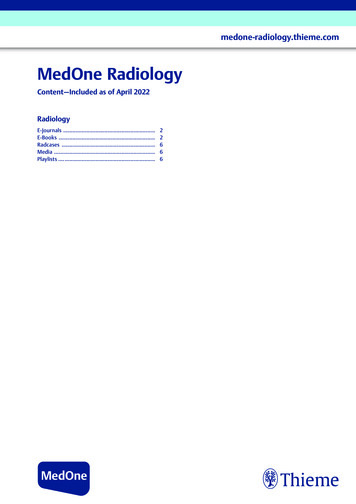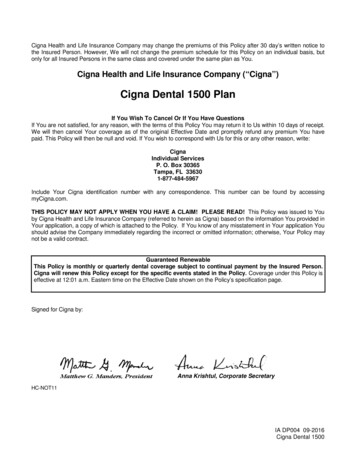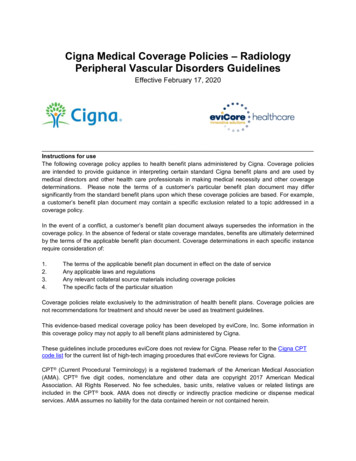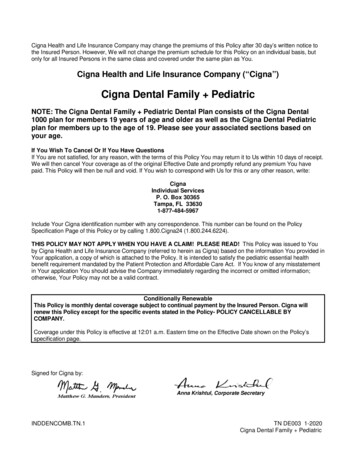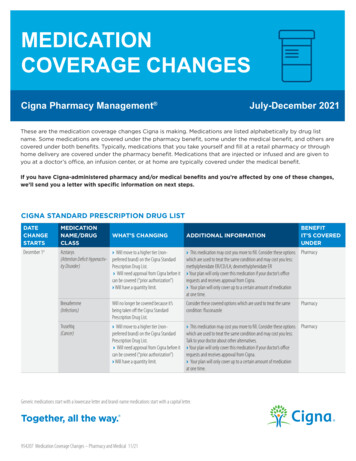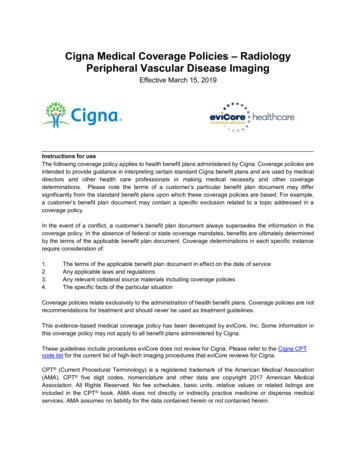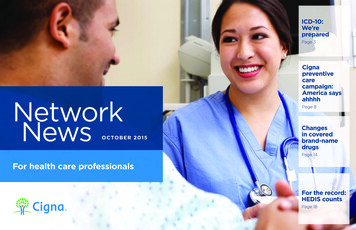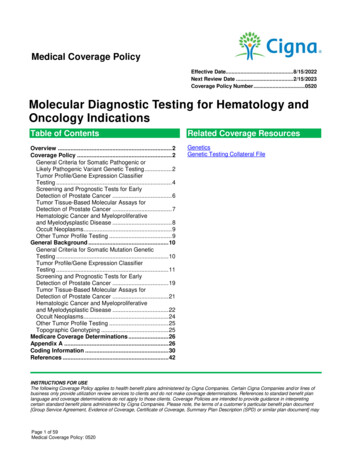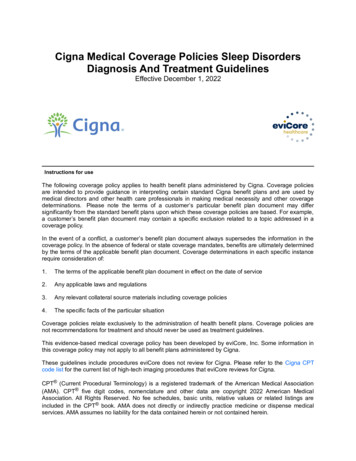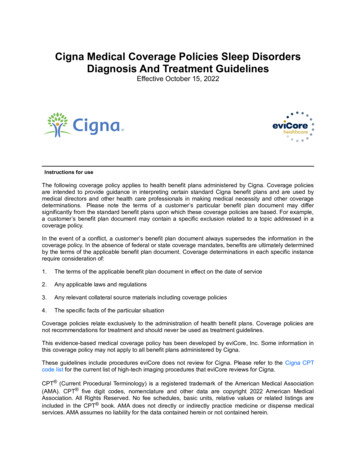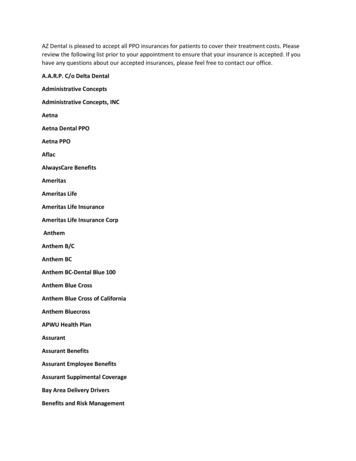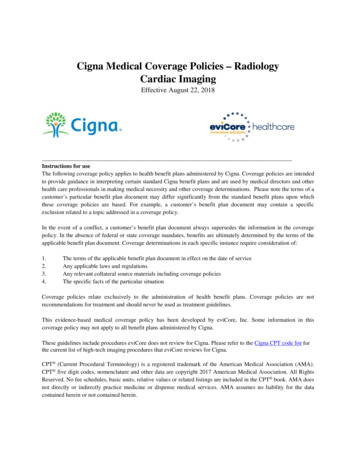
Transcription
Cigna Medical Coverage Policies – RadiologyCardiac ImagingEffective August 22, 2018Instructions for useThe following coverage policy applies to health benefit plans administered by Cigna. Coverage policies are intendedto provide guidance in interpreting certain standard Cigna benefit plans and are used by medical directors and otherhealth care professionals in making medical necessity and other coverage determinations. Please note the terms of acustomer’s particular benefit plan document may differ significantly from the standard benefit plans upon whichthese coverage policies are based. For example, a customer’s benefit plan document may contain a specificexclusion related to a topic addressed in a coverage policy.In the event of a conflict, a customer’s benefit plan document always supersedes the information in the coveragepolicy. In the absence of federal or state coverage mandates, benefits are ultimately determined by the terms of theapplicable benefit plan document. Coverage determinations in each specific instance require consideration of:1.2.3.4.The terms of the applicable benefit plan document in effect on the date of serviceAny applicable laws and regulationsAny relevant collateral source materials including coverage policiesThe specific facts of the particular situationCoverage policies relate exclusively to the administration of health benefit plans. Coverage policies are notrecommendations for treatment and should never be used as treatment guidelines.This evidence-based medical coverage policy has been developed by eviCore, Inc. Some information in thiscoverage policy may not apply to all benefit plans administered by Cigna.These guidelines include procedures eviCore does not review for Cigna. Please refer to the Cigna CPT code list forthe current list of high-tech imaging procedures that eviCore reviews for Cigna.CPT (Current Procedural Terminology) is a registered trademark of the American Medical Association (AMA).CPT five digit codes, nomenclature and other data are copyright 2017 American Medical Association. All RightsReserved. No fee schedules, basic units, relative values or related listings are included in the CPT book. AMA doesnot directly or indirectly practice medicine or dispense medical services. AMA assumes no liability for the datacontained herein or not contained herein.
Imaging GuidelinesV20.0.2018Cardiac Imaging Guidelines34516263341464955586163Cardiac ImagingAbbreviations For Cardiac Imaging GuidelinesGlossaryCD-1: General GuidelinesCD-2: Echocardiography (ECHO)CD-3: Nuclear Cardiac ImagingCD-4: Cardiac CT, Coronary CTA, and CT for CoronaryCalcium(CAC)CD-5: Cardiac MRICD-6: Cardiac PETCD-7: Diagnostic Heart CatheterizationCD-8: Pulmonary Artery and Vein ImagingCD-9: Congestive Heart FailureCD-10: Cardiac TraumaCD-11: Section left intentionally blank 2018 eviCore healthcare. All Rights Reserved.Page 2 of 63400 Buckwalter Place Boulevard, Bluffton, SC 29910 (800) 918-8924www.eviCore.com
Imaging merican College of Cardiologyacute coronary syndromeAmerican Heart AssociationAnglo-Scandinavian Cardiac Outcomes Trialatrial septal defectbody mass indexcoronary artery bypass graftingcoronary artery diseasecongestive heart failurechronic obstructive pulmonary diseasecomputed tomographycoronary computed tomography angiographycomputed tomography angiographyelectron beam computed tomographyexternal counterpulsation (also known as EECP)electrocardiogramexternal counterpulsationexercise treadmill stress testFluorodeoxyglucose, a radiopharmaceutical used to measure myocardialmetabolismhypertrophic cardiomyopathyintravenousleft anterior descending coronary arterylow density lipoprotein cholesterolleft heart catheterizationleft ventricleleft ventricular ejection fractionmyocardial infarctionmyocardial perfusion imaging (SPECT study, nuclear cardiac study)magnetic resonance angiographymagnetic resonance imagingmillisievert (a unit of radiation exposure) equal to an effective dose of a joule ofenergy per kilogram of recipient massmulti gated acquisition scan of the cardiac blood poolpercutaneous coronary intervention (includes percutaneous coronaryangioplasty (PTCA) and coronary artery stenting)positron emission tomographypercutaneous coronary angioplastyright heart catheterizationsingle photon emission computed tomographytransesophageal echocardiogramTransient Ischemic Attackventricular septal defect 2018 eviCore healthcare. All Rights Reserved.Page 3 of 63400 Buckwalter Place Boulevard, Bluffton, SC 29910 (800) 918-8924www.eviCore.comCardiac ImagingAbbreviations for Cardiac Imaging Guidelines
Imaging GuidelinesV20.0.2018GlossaryAgatston Score: a nationally recognized calcium score for the coronary arteriesbased on Hounsfield units and size (area) of the coronary calciumAngina: principally chest discomfort, exertional (or with emotional stress) and relievedby rest or nitroglycerineAnginal variants or equivalents: a manifestation of myocardial ischemia which isperceived by individuals to be (otherwise unexplained) dyspnea, unusual fatigue,more often seen in women and may be unassociated with chest painARVD/ARVC – Arrhythmogenic Right Ventricular Dysplasia/Cardiomyopathy: apotentially lethal inherited disease with syncope and rhythm disturbances, includingsudden death, as presenting manifestationsBNP: B-type natriuretic peptide, blood test used to diagnose and track heart failure(n-T-pro-BNP is a variant of this test)Brugada Syndrome: an electrocardiographic pattern that is unique and might be amarker for significant life threatening dysrhythmiasDouble Product (Rate Pressure Product): an index of cardiac oxygen consumption,is the systolic blood pressure times heart rate, generally calculated at peak exercise;over 25000 means an adequate stress load was performedFabry’s Disease: an infiltrative cardiomyopathy, can cause heart failure andarrhythmiasHibernating myocardium: viable but poorly functioning or non-functioningmyocardium which likely could benefit from intervention to improve myocardial bloodsupplyOptimized Medical Therapy should include (where tolerated): antiplatelet agents,calcium channel antagonists, partial fatty acid oxidase inhibitors (e.g. ranolazine),statins, short-acting nitrates as needed, long-acting nitrates up to 6 months after anacute coronary syndrome episode, beta blocker drugs (optional), angiotensinconverting enzyme (ACE) inhibitors/angiotensin receptor blocking (ARB) agents(optional)Silent ischemia: cardiac ischemia discovered by testing only and not presenting as asyndrome or symptomsSyncope: loss of consciousness; near-syncope is not syncopeTakotsubo cardiomyopathy: apical dyskinesis oftentimes associated with extremestress and usually thought to be reversibleTroponin: a marker for ischemic injury, primarily cardiac 2018 eviCore healthcare. All Rights Reserved.Page 4 of 63400 Buckwalter Place Boulevard, Bluffton, SC 29910 (800) 918-8924www.eviCore.comCardiac ImagingPlatypnea: shortness of breath when upright or seated (the opposite of orthopnea)and can indicate cardiac malformations, shunt or tumor
Imaging GuidelinesV20.0.2018CD-1: General Guidelines688810111212Cardiac ImagingCD-1.1: General Issues – CardiacCD-1.2: Stress Testing without Imaging – ProceduresCD-1.3: Stress Testing with Imaging-ProceduresCD-1.4: Stress Testing with Imaging – IndicationsCD-1.5: Stress Testing with Imaging - PreoperativeCD-1.6: Transplant IndividualsCD-1.7: Non-imaging Heart Function and Cardiac Shunt ImagingCD-1.8: Section left intentionally blank 2018 eviCore healthcare. All Rights Reserved.Page 5 of 63400 Buckwalter Place Boulevard, Bluffton, SC 29910 (800) 918-8924www.eviCore.com
Imaging GuidelinesV20.0.2018Practice Estimate of Effective Radiation Dose chart for SelectedImaging StudiesIMAGING STUDYSestamibi myocardial perfusion study (MPI)PET myocardial perfusion study:Rubidium-82NH3Thallium myocardial perfusion study (MPI)Diagnostic conventional coronary angiogram (cath)Computed tomography coronary angiography (CTCA)(with prospective gating)CT of Abdomen and pelvisChest x-rayEstimate of EffectiveRadiation Dose9-12 mSv3 mSV2 mSV22-31 mSv5-10 mSv5-15 mSvLess than 5 mSv8-14 mSv 0.1 mSvCD-1.1: General Issues – Cardiac A current clinical evaluation (within 60 days) is required prior to consideringadvanced imaging, which includes: Relevant history and physical examination and appropriate laboratory studiesand non-advanced imaging modalities, such as recent ECG (within 60 days),chest x-ray or ECHO/ultrasound, after symptoms started or worsened. Effort should be made to obtain copies of reported “abnormal” ECG studies inorder to determine whether the ECG is uninterpretable. Most recent previous stress testing and its findings Other meaningful contact (telephone call, electronic mail or messaging) by anestablished individual can substitute for a face-to-face clinical evaluation. Vital signs, height and weight or BMI or description of general habitus is needed. Advanced imaging should answer a clinical question which will affectmanagement of the individual’s clinical condition. Assessment of coronary artery disease can be determined by the following: Typical angina (definite): Substernal chest discomfort (generally described as pressure, heaviness,burning, or tightness) Generally brought on by exertion or emotional stress and relieved by rest May radiate to the left arm or jaw When clinical information is received indicating that an individual isexperiencing chest pain that is "exertional" or "due to emotional stress",this meets the typical angina definition under the Pre-Test Probability Grid.No further description of the chest pain is required (location within thechest is not required). The Pre-Test Probability Grid (Table 1) is based on age, gender, andsymptoms. All factors must be considered in order to approve for stresstesting with imaging using the Pre-Test Probability Grid. 2018 eviCore healthcare. All Rights Reserved.Page 6 of 63400 Buckwalter Place Boulevard, Bluffton, SC 29910 (800) 918-8924www.eviCore.comCardiac Imaging Cardiac imaging is not indicated if the results will not affect individual managementdecisions. If a decision to perform cardiac catheterization or other angiography hasalready been made, there is often no need for imaging stress testing.
Imaging GuidelinesV20.0.2018 Atypical angina (probable): Chest pain or discomfort (arm or jaw pain) thatlacks one of the characteristics of definite or typical angina. Non-anginal chest pain: Chest pain or discomfort that meets one or none ofthe typical angina characteristics. Anginal variants or equivalents: a manifestation of myocardial ischemiawhich is perceived by individuals to be (otherwise unexplained) dyspnea,unusual fatigue, more often seen in women and may be unassociated withchest pain.Table 1:Pre-Test Probability of CAD by Age, Gender, and SymptomsAge (years)39 andyounger40 - 4950 - 5960 and overMenTypical teVery lowVery lowVery iateLowVery lowVery iateIntermediateLowVery rmediateIntermediateLowGenderAtypical /ProbableAngina PectorisNonanginalChest PainAsymptomaticIntermediateLowVery lowGreater than 90% pre-test probabilityIntermediateBetween 10% and 90% pre-test probabilityLowBetween 5% and 10% pre-test probabilityVery LowLess than 5% pre-test probabilityCardiac ImagingHigh 2018 eviCore healthcare. All Rights Reserved.Page 7 of 63400 Buckwalter Place Boulevard, Bluffton, SC 29910 (800) 918-8924www.eviCore.com
Imaging GuidelinesV20.0.2018CD-1.2: Stress Testing without Imaging – ProceduresThe Exercise Treadmill Test (ETT) is without imaging. Necessary components of an ETT include: ECG that can be interpreted for ischemia. Individual capable of exercise on a treadmill or similar device (generally at 4METs or greater; see functional capacity below). An abnormal ETT (exercise treadmill test) includes any one of the following: ST segment depression (usually described as horizontal or downsloping, greateror equal to 1.0 mm below baseline) Development of chest pain Significant arrhythmia (especially ventricular arrhythmia) Hypotension Functional capacity greater than or equal to 4 METs equates to the following: Can walk four blocks without stopping Can walk up a hill Can climb one flights of stairs without stopping Can perform heavy work around the houseBackground and Supporting InformationAn observational study found that, compared with the Duke Activity Status Index,subjective assessment by clinicians generally underestimated exercise capacity (seereference 25).CD-1.3: Stress Testing with Imaging-Procedures Imaging Stress Tests include any one of the following: Stress Echocardiography (see CD-2.6: Stress Echocardiography (StressEcho) – Coding) MPI (see CD-3.1: Myocardial Perfusion Imaging (MPI) – Coding) Stress perfusion MRI (see CD-5.3: Cardiac MRI – Indications for Stress MRI) Stress testing with imaging can be performed with maximal exercise or chemicalstress (dipyridamole, dobutamine, adenosine, or regadenoson) and does not alterthe CPT codes used to report these studies. Stress echo, MPI or stress MRI for the following: New, recurrent or worsening cardiac symptoms AND with any of the following: High pretest probability (greater than 90% probability of CAD) per Table 1 A history of CAD based on: A prior anatomic evaluation of the coronaries OR A history of CABG or PCI Evidence or high suspicion of ventricular tachycardia Age 40 years or greater and known diabetes mellitus Coronary calcium score / 100 2018 eviCore healthcare. All Rights Reserved.Page 8 of 63400 Buckwalter Place Boulevard, Bluffton, SC 29910 (800) 918-8924www.eviCore.comCardiac ImagingCD-1.4: Stress Testing with Imaging – Indications
V20.0.2018 Poorly controlled hypertension defined as systolic BP greater than or equal to180mmhg, if provider feels strongly that CAD needs evaluation prior to BPbeing controlled. ECG is uninterpretable for ischemia due to any one of the following: Complete Left Bundle Branch Block (bifasicular block involving rightbundle branch and left anterior hemiblock does not render ECGuninterpretable for ischemia) Ventricular paced rhythm Pre-excitation pattern such as Wolff-Parkinson-White Greater or equal to 1.0 mm ST segment depression (NOT nonspecificST/T wave changes) LVH with repolarization abnormalities, also called LVH with strain (NOTwithout repolarization abnormalities or by voltage criteria) T wave inversion in the inferior and/or lateral leads. This includes leads II,AVF, V5 or V6. (T wave inversion isolated in lead III or T wave inversion inlead V1 and V2 are not included). Individual on digitalis preparation Continuing symptoms in an individual who had a normal or submaximalexercise treadmill test and there is suspicion of a false negative result. Individuals with recent equivocal, borderline, or abnormal stress testing whereischemia remains a concern. Heart rate less than 50 bpm in individuals on beta blocker and/or calciumchannel blocker medication where it is felt that the individual may not achievean adequate workload for a diagnostic exercise study. Inadequate ETT: Physical inability to achieve target heart rate (85% MPHR or 220-age.Target heart rate is calculated as 85% of the maximum age predictedheart rate (MPHR). MPHR is estimated as 220 minus the individual's age. History of false positive exercise treadmill test: a false positive ETT is onethat is abnormal however the abnormality does not appear to be due tomacrovascular CAD. One MPI can be performed within 3 months of an acute coronary syndrome (e.g.ST segment elevation MI [STEMI], unstable angina, non-ST segment elevationMI [NSTEMI]), to evaluate for inducible ischemia if all of the following related tothe mostrecent acute coronary event apply: Individual is hemodynamically stable No recurrent chest pain symptoms and no signs of heart failure No prior coronary angiography or imaging stress test in regards to the currentepisode of symptoms Assessing myocardial viability in individuals with significant ischemic ventriculardysfunction (suspected hibernating myocardium) and persistent symptoms orheart failure such that revascularization would be considered. MRI, cardiac PET, MPI, or Dobutamine stress echo can be used to assessmyocardial viability depending on physician preference. 2018 eviCore healthcare. All Rights Reserved.Page 9 of 63400 Buckwalter Place Boulevard, Bluffton, SC 29910 (800) 918-8924www.eviCore.comCardiac ImagingImaging Guidelines
Imaging Guidelines V20.0.2018 PET and MPI perfusion studies are usually accompanied by PET metabolicexaminations (CPT 78459). Tl-201 MPI perfusion studies may assessviability without accompanying PET metabolism information.Unheralded syncope (not near syncope)Asymptomatic individual with an uninterpretable ECG that: Has never been evaluated or Is a new uninterpretable change.Individual with an elevated cardiac troponin.One routine study 2 years or more after a stent Except with a left main stent where it can be done at 1 year.One routine study at 5 years or more after CABG, without cardiac symptoms.Every 2 years if there was documentation of previous “silent ischemia” on theimaging portion of a stress test but not on the ECG portion.To assess for CAD prior to starting a Class IC antiarrhythmic agent (flecainide orpropafenone) and annually while taking the medication.Prior anatomic imaging study (coronary angiogram or CCTA) demonstratingcoronary stenosis in a major coronary branch, which is of uncertain functionalsignificance, can have one stress test with imaging. Evaluating new, recurrent, or worsening left ventricular dysfunction/CHF (see CD9.1: CHF– Imaging for additional indications). There are 2 steps that determine the need for imaging stress testing in (stable) preoperative individuals: Would the individual qualify for imaging stress testing independent of plannedsurgery? If yes, proceed to stress testing guidelines; If no, go to step 2 Is the surgery considered high, moderate or low risk? (see Table 2) If high ormoderate-risk, proceed below. If low-risk, there is no evidence to determine aneed for preoperative cardiac testing. High Risk Surgery: All individuals in this category should receive an imagingstress test if there has not been an imaging stress test within 1 year*, unlessthe individual has developed new cardiac symptoms or a new change in theEKG since the last stress test. Intermediate Surgery: One or more risk factors and unable to perform anETT per guidelines if there has not been an imaging stress test within 1 year*unless the individual has developed new cardiac symptoms or a new changein the EKG since the last stress test. Low Risk: Preoperative imaging stress testing is not supported. Clinical Risk Factors (for cardiac death & non-fatal MI at time of non-cardiacsurgery) Planned high risk surgery (open surgery on the aorta or open peripheralvascular surgery) History of ischemic heart disease (previous MI, previous positive stress test,use of nitroglycerin, typical angina, ECG Q waves, previous PCI or CABG) 2018 eviCore healthcare. All Rights Reserved.Page 10 of 63400 Buckwalter Place Boulevard, Bluffton, SC 29910 (800) 918-8924www.eviCore.comCardiac ImagingCD-1.5: Stress Testing with Imaging - Preoperative
Imaging GuidelinesV20.0.2018 History of compensated previous congestive heart failure (history of heartfailure, previous pulmonary edema, third heart sound, bilateral rales, chest xray showing heart failure) History of previous TIA or stroke Diabetes Mellitus Creatinine level 2 mg/dL*Time interval is based on consensus of eviCore executive cardiology panel.Table 2Cardiac Risk Stratification ListHigh Risk ( 5%) Open aortic and othermajor open vascularsurgery Open peripheral vascularsurgeryIntermediate Risk (1-5%) Open intraperitoneal and/or intrathoracicsurgeryOpen carotidendarterectomyHead and neck surgeryOpen orthopedic surgeryOpen prostate surgeryLow Risk ( 1%) Endoscopic proceduresSuperficial proceduresCataract surgeryBreast surgeryAmbulatory surgeryLaparoscopic andendovascular proceduresthat are unlikely to requirefurther extensive surgicalinterventionCD-1.6: Transplant Individuals Post-Cardiac transplant assessment of transplant CAD: ONE of the following imaging studies may be performed annually: MPI Stress ECHO Stress MRI Cardiac PET perfusion with coronary flow quantitation (CPT 78491 or CPT 78492) 2018 eviCore healthcare. All Rights Reserved.Page 11 of 63400 Buckwalter Place Boulevard, Bluffton, SC 29910 (800) 918-8924www.eviCore.comCardiac Imaging Stress Testing in individuals for Non-Cardiac Transplant Individuals who are candidates for any type of organ bone marrow or stem celltransplant can undergo imaging stress testing every year (usually stress echo orMPI) prior to transplant. Individuals who have undergone organ transplant are at increased risk forischemic heart disease secondary to their medication. Risk of vasculopathy is 7%at one year, 32% at five years and 53% at ten years. An imaging stress test canbe repeated annually after transplant for at least two years or within one year of aprior cardiac imaging study if there is evidence of progressive vasculopathy. After two consecutive normal imaging stress tests, repeated testing is notsupported more often than every other year without evidence for progressivevasculopathy or new symptoms. Stress testing after five years may proceed according to normal patterns ofconsideration.
Imaging GuidelinesV20.0.2018CD-1.7: Non-imaging Heart Function and Cardiac Shunt Imaging Echocardiogram is the preferred method for cardiac shunt detection. Echocardiogram, MPI, MUGA study, cardiac MRI, cardiac CT, or cardiac PET toobtain ejection fraction depending on the clinical situation.Background and Supporting Information Procedures reported with CPT 78414 and CPT 78428 are essentially obsolete andshould not be performed in lieu of other preferred modalities.Cardiac ImagingCD-1.8: Section left intentionally blank 2018 eviCore healthcare. All Rights Reserved.Page 12 of 63400 Buckwalter Place Boulevard, Bluffton, SC 29910 (800) 918-8924www.eviCore.com
Imaging GuidelinesV20.0.20181. Adabag AS, Grandits GA, Prineas RJ, et al. Relation of Heart Rate Parameters During Exercise Testto Sudden Death and All-Cause Mortality In Asymptomatic Men. Am J Cardiol. 2008;101:1437-1443.Accessed November 30, 2017. 0002914908001598.2. Fihn SD, Gardin JM, Abrams J, et al. 2012 ACCF/AHA/ACP/AATS/PCNA/SCAI/STS Guideline for thediagnosis and management of patients with stable ischemic heart disease: a report of the AmericanCollege of Cardiology Foundation/American Heart Association Task Force on Practice Guidelines,and the American College of Physicians, American Association for Thoracic Surgery, PreventiveCardiovascular Nurses Association, Society for Cardiovascular Angiography and Interventions, andSociety of Thoracic Surgeons. J Am Coll Cardiol. 2012;60:e44. Accessed November 30, 97.3. Qaseem A, Fihn SD, Williams S, et al. Diagnosis of stable ischemic heart disease: summary of aclinical practice guideline from the American College of Physicians/American College of CardiologyFoundation/American Heart Association/American Association for Thoracic Surgery/PreventiveCardiovascular Nurses Association/Society of Thoracic Surgeons. Ann Intern Med. 2012;157:729.Accessed November 30, 2017. actice-guideline-from.4. Rybicki FJ, Udelson JE, Peacock WF, et al. R/SCPC/SNMMI/STR/STSAppropriate Utilization of Cardiovascular Imaging in Emergency Department Patients With ChestPain: A Joint Document of the American College of Radiology Appropriateness Criteria Committeeand the American College of Cardiology Appropriate Use Criteria Task Force. J Am Coll Cardiol.2016;67:853. Accessed November 30, 2017.http://www.onlinejacc.org/content/67/7/853? ga 85.5. Fleisher LA, Fleischmann KE, Auerbach AD, et al. 2014 ACC/AHA Guideline on PerioperativeCardiovascular Evaluation and Management of Patients Undergoing Noncardiac Surgery: A Report ofthe American College of Cardiology/American Heart Association Task Force on Practice Guidelines. JAm Coll Cardiol 2014. Accessed November 30, pii/S0735109714055363?via%3Dihub.6. Friedewald VE, King SB, Pepine CJ, et.al. The Editor’s Roundtable: Chronic stable angina pectoris.Am J Cardiol. 2007 Dec;100(11):1635-1643. Accessed November 30, 7)01706-7/fulltext.7. Gibbons RJ, Balady GJ, Bricker JT, et al. ACC/AHA 2002 Guideline Update for Exercise TestingSummary Article. A report of the American College of Cardiology/American Heart Association TaskForce on Practice Guidelines (Committee to Update the 1997 Exercise Testing Guidelines). J Am CollCardiol. 2002;40:1531-1540. Accessed November 30, 83.long.8. Ho PM, Rumsfeld JS, Peterson PN. Chest pain on exercise treadmill test predicts future cardiachospitalizations. ClinCardiol. 2007;30:505-510. Accessed November 30, c.20139/abstract.9. Lauer MS, Pothier CE, Magid DJ, et al. An externally validated model for predicting long-term survivalafter exercise treadmill testing in patients with suspected coronary artery disease and a normalelectrocardiogram. Ann Intern Med. 2007;147:821-828. Accessed November 30, urvivalafter-exercise-treadmill?doi 10.7326%2f0003-4819-147-12-200712180-00001.10. Marshall AJ, Hutchings F, James AJ, et al. Prognostic value of a nine minute treadmill test in patientsundergoing myocardial perfusion scintigraphy. Am J Cardiol. 2010 Nov;106(10):1423-1428. AccessedNovember 30, 2017. 08-6/fulltext.11. Mieres JH and Blumenthal RS. Does the treadmill test work in women? Cardiosource Spotlight. 2008Jul 1;CS2-CS4. Accessed November 30, 2017. https://www.medscape.com/viewarticle/578141 3.12. Peterson PN, Magid DJ, Ross C, et al. Association of exercise capacity on treadmill with futurecardiac events in patients referred for exercise testing. Arch Intern Med. 2008;168(2):174-179.Accessed November 30, medicine/fullarticle/413829. 2018 eviCore healthcare. All Rights Reserved.Page 13 of 63400 Buckwalter Place Boulevard, Bluffton, SC 29910 (800) 918-8924www.eviCore.comCardiac ImagingReferences
V20.0.201813. Picano E, Pasanisi E, Brown J, et al. A gatekeeper for the gatekeeper: Inappropriate referrals tostress echocardiography. Am Heart J. 2007;154:285-290. Accessed November 30, 7)00356-0/fulltext.14. Poirier P, Alpert MA, Fleisher LA, et al. Cardiovascular evaluation and management of severelyobese patients undergoing surgery: a science advisory from the American Heart Association.Circulation. 2009;120:86-95. Accessed November 30, 15. Sechtem U. Do heart transplant recipients need annual coronary angiography? European HeartJournal. 2001;22:895–897. Accessed November 30, /11/895/524959.16. Southard J, Baker L, Schaefer S. In search of the false-negative exercise treadmill testing evidencebased use of exercise echocardiography. ClinCardiol. 2008;31:35-40. Accessed November 30, c.20174/abstract.17. Tavel ME. Stress testing in cardiac evaluation: Current concepts with emphasis on the ECG. Chest.2001;119:907-925. Accessed November 30, 2017. 1692-9/fulltext.18. Taylor DO, Edwards LB, Boucek MM, et al. Registry of the International Society for Heart and LungTransplantation: Twenty-fourth official adult heart transplant report—2007. J Heart Lung Transplant.2007 August;26(8):769-781. Accessed November 30, 2017. 06-2/fulltext.19. Diamond GA. A clinically relevant classification of chest discomfort. J Am CollCardiol.1983;1:574–5.Accessed November 30, pii/S073510978380093X?via%3Dihub.20. Wolk MJ, Bailey SR, Doherty JU, Douglas PS, Hendel RC, Kramer CM, Min JK, Patel MR,Rosenbaum L, Shaw LJ, Stainback RF, Allen JM.ACCF/AHA/ASE/ASNC/HFSA/HRS/SCAI/SCCT/SCMR/STS. 2013 Multi-modality appropriate usecriteria for the detection and risk assessment of stable ischemic heart disease: a report of theAmerican College of Cardiology Foundation, Appropriate Use Criteria Task Force, American HeartAssociation, American Society of Echocardiography, American Society of Nuclear Cardiology, HeartFailure Society of America, Heart Rhythm Society, Society for Cardiovascular Angiography andInterventions, Society of Cardiovascular Computed Tomography, Society for Cardiovascular MagneticResonance, and Society of Thoracic Surgeons. J Am CollCardiol. 2014;63. Accessed November 30,2017. 74-8/fulltext.21. Blank P, Scheopf UJ, Leipsic JA. CT in transcatheter aortic valve replacement. Radiology.2013;269(3). Accessed November 30, 2017. http://pu
The following coverage policy applies to health benefit plans administered by Cigna. Coverage policies are intended to provide guidance in interpreting certain standard Cigna benefit plans and are used by medical directors and other health care professionals in making medical necessity and other coverage determinations. Please note the terms of a
